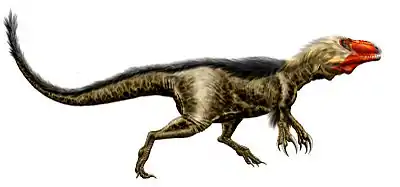Navesink-Formation
Die Navesink-Formation ist eine Abfolge von glaukonitischem Mergel und Sand des Maastrichtiums der oberen Kreide im US-Bundesstaat New Jersey. Ähnlich wie in der bekannteren Hell-Creek-Formation hat man auch in der Navesink-Formation verschiedene fossile Taxa gefunden, welche während des Maastrichtiums der Oberkreide bis zur Kreide-Paläogen-Grenze gelebt haben.[1] Benannt wurde die Navesink-Formation nach dem nahegelegenen Ort Navesink in New Jersey. Die Navesink-Formation liegt über der Mount Laurel-Formation und unter der Red Bank Formation. Die Mount Laurel-Formation entstand etwa 5 Mio. Jahre nach der Navesink-Formation. Während ihres Verlaufs von Sandy Hook bis Pennsvile variiert die Breite der Formation zwischen 14 m bis 20 m. Die Navesink-Formation enthält auch die Campanium-Maastrichtium-Grenze.[2]
Fauna

Die Navesink-Formation hat einen großen Teil der damaligen Fauna konserviert und enthält somit Fossilien vieler verschiedener Taxa. Beispielsweise hat man in der Navesink-Formation einige Spezies von Ammoniten gefunden, beispielsweise Nostoceras approximans.[3] Des Weiteren wurden einige Dinosaurierfossilien in der Formation gefunden, so beispielsweise den Tyrannosauroiden Dryptosaurus aquilungis[4] oder einen bislang unbenannten Vertreter der Ornithomimidae.[5] Auch der Ornithomimidae "Coelosaurus" antiquus wurde in der Formation gefunden. Auch einen bislang unbeschriebenen Vertreter der Nodosauridae fand man hier.[6] Dies bezeugt eine hohe Artenvielfalt der Taxa, welche in zur damaligen Zeit im Gebiet des heutigen New Jersey lebten. Die meisten dieser Arten lebten bis zum großen Massenaussterben an der Kreide-Paläogen-Grenze, während welcher alle „Nichtvogel“- Dinosaurier ausstarben.
Fossilienfundstellen
Die Navesink-Formation ist an mehreren Orten deutlich sichtbar, beispielsweise im Big Brook Park in Marlboro, New Jersey.
Weblinks
Einzelnachweise
- Internet Archive: When dinosaurs roamed New Jersey. Rutgers University Press, 1997, ISBN 978-0-8135-2348-4 (archive.org [abgerufen am 18. Januar 2021]).
- Fred Eugene May: Dinoflagellate cysts of the Gymnodiniaceae, Peridiniaceae, and Gonyaulacaceae from the Upper Cretaceous Monmouth Group, Atlantic Highlands, New Jersey. 1976 (vt.edu [abgerufen am 18. Januar 2021]).
- W. J. Kennedy, N. H. Landman, W. A. Cobban, R. O. Johnson: Additions to the Ammonite Fauna of the Upper Cretaceous Navesink Formation of New Jersey. In: American Museum Novitates. Band 2000, Nr. 3306, Dezember 2000, ISSN 0003-0082, S. 1–30, doi:10.1206/0003-0082(2000)3062.0.CO;2 (bioone.org [abgerufen am 18. Januar 2021]).
- Chase D. Brownstein: The biogeography and ecology of the Cretaceous non-avian dinosaurs of Appalachia. In: Palaeontologia Electronica. Band 21, Nr. 1, 8. Februar 2018, ISSN 1094-8074, S. 1–56, doi:10.26879/801 (palaeo-electronica.org [abgerufen am 18. Januar 2021]).
- Chase D. Brownstein: Theropod specimens from the Navesink Formation and their implications for the Diversity and Biogeography of Ornithomimosaurs and Tyrannosauroids on Appalachia. e3105v1. PeerJ Preprints, 24. Juli 2017 (peerj.com [abgerufen am 18. Januar 2021]).
- Chase D. Brownstein: The biogeography and ecology of the Cretaceous non-avian dinosaurs of Appalachia. In: Palaeontologia Electronica. Band 21, Nr. 1, 8. Februar 2018, ISSN 1094-8074, S. 1–56, doi:10.26879/801 (palaeo-electronica.org [abgerufen am 18. Januar 2021]).